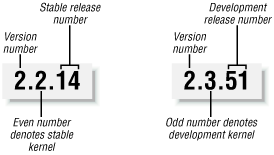1.3. Linux Versions
Linux distinguishes stable kernels from development kernels through a simple numbering scheme. Each version is characterized by three numbers, separated by periods. The first two numbers are used to identify the version; the third number identifies the release.
As shown in Figure 1-1, if the second number is even, it denotes a stable kernel; otherwise, it denotes a development kernel. At the time of this writing, the current stable version of the Linux kernel is 2.2.14, and the current development version is 2.3.51. The 2.2 kernel, which is the basis for this book, was first released in January 1999, and it differs considerably from the 2.0 kernel, particularly with respect to memory management. Work on the 2.3 development version started in May 1999.
Figure 1-1. Numbering Linux versions

New releases of a stable version come out mostly to fix bugs reported by users. The main algorithms and data structures used to implement the kernel are left unchanged.
Development versions, on the other hand, may differ quite significantly from one another; kernel developers are free to experiment with different solutions that occasionally lead to drastic kernel changes. Users who rely on development versions for running applications may experience unpleasant surprises when upgrading their kernel to a newer release. This book concentrates on the most recent stable kernel ...
Get Understanding the Linux Kernel now with the O’Reilly learning platform.
O’Reilly members experience books, live events, courses curated by job role, and more from O’Reilly and nearly 200 top publishers.

